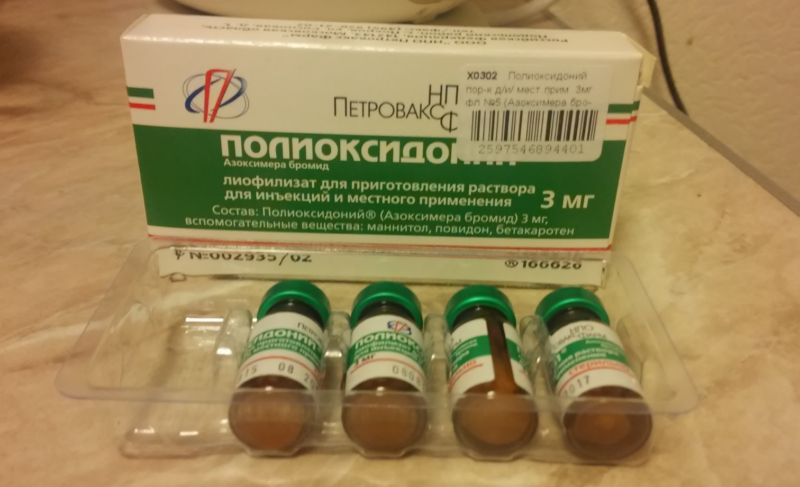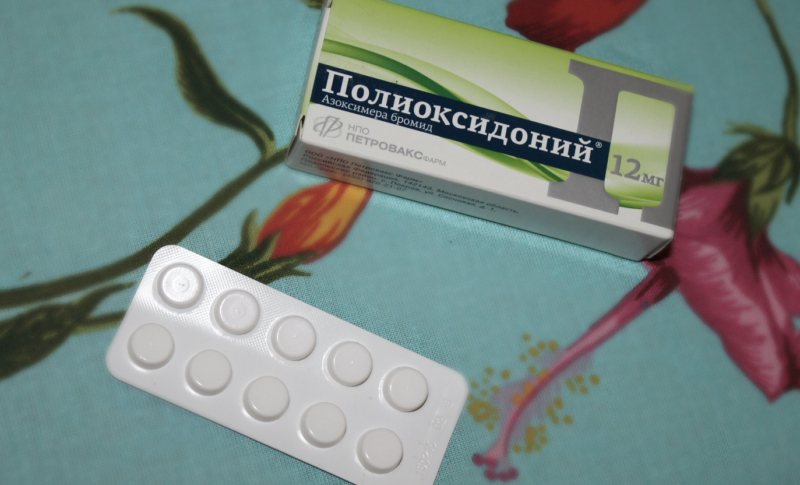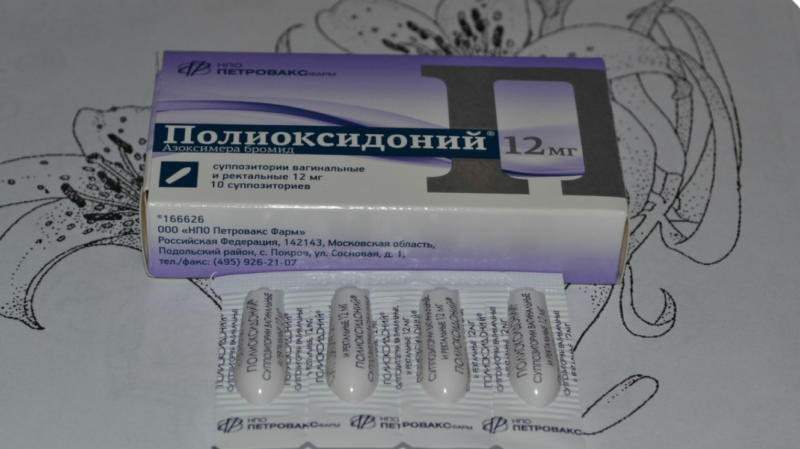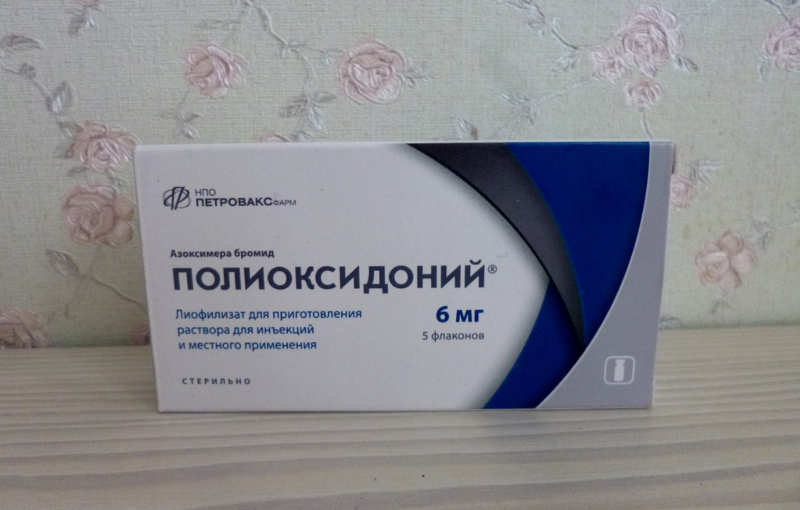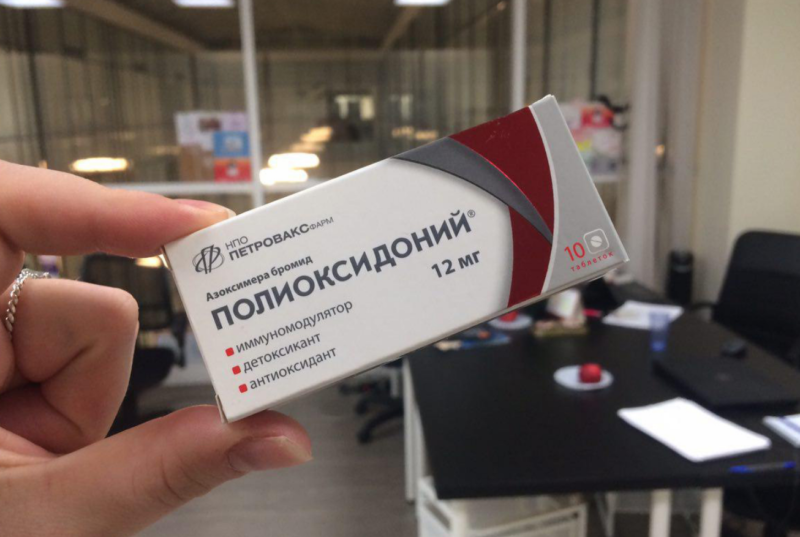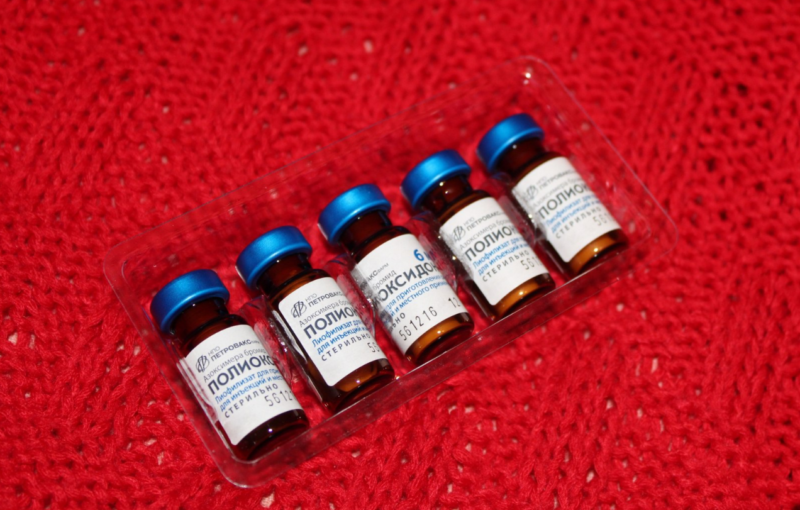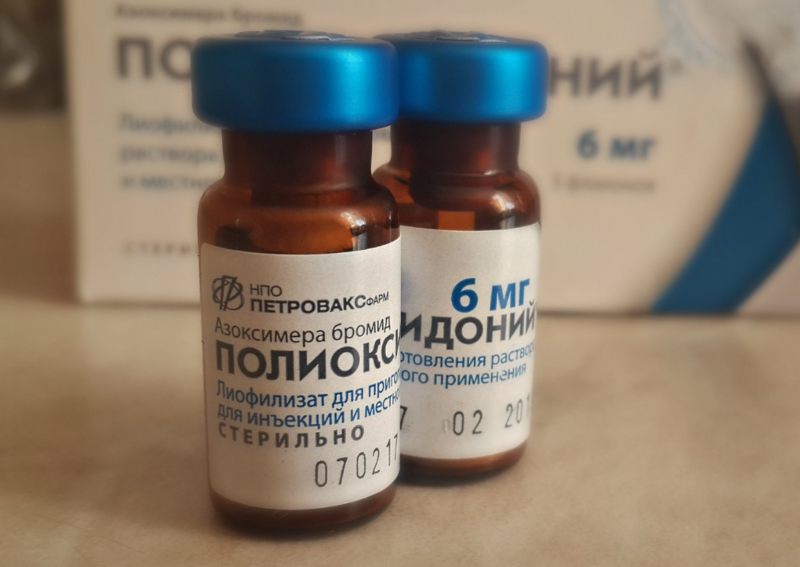In this publication, we consider the instructions for the use of "Polyoxidonium". This is a popular immunomodulator, it is prescribed for both adults and children. We learn about the possible consequences of taking the drug, indications and contraindications.
Material Content:
- 1 Description of release forms and composition
- 2 Pharmacological action, pharmacodynamics and pharmacokinetics
- 3 What helps Polyoxidonium
- 4 Instructions for use and dosage
- 5 During pregnancy and lactation
- 6 Alcohol compatibility
- 7 Drug interaction
- 8 Contraindications, side effects and overdose
- 9 Analogues of Polyoxidonium
Description of release forms and composition
The medicine is made in three forms.
The patient may be prescribed:
- Polyoxidonium tablets 12 mg;
- "Polyoxidonium" suppositories (rectal and vaginal use is possible) 12 and 6 mg;
- injections "Polyoxidonium" (not ready-made solutions, but lyophilisate) of 6 and 3 mg.
In whatever form the drug is prescribed, its main component will be azoximer bromide.
Additional ingredients:
- Candles: cocoa butter, povidone, mannitol.
- Tablets: potato starch, stearic acid, povidone, mannitol, lactose monohydrate.
- Injections: betacarotene, mannitol and povidone.
Pharmacological action, pharmacodynamics and pharmacokinetics
The immuno-modeling property of "Polyoxidonium" is determined by the fact that it makes the resistance of the human body to infections higher. The drug activates the natural production of antibodies, directly affects phagocytic cells of organs.
The tool is designed to restore and increase the human immunity in case of deficiency after surgery, cancer, various injuries, autoimmune diseases, the use of certain medications.
The high molecular origin and special structure of the drug gives it antioxidant and detoxifying properties.
The tool helps the body cleanse itself of toxins and other harmful substances that poison the body. Such activity of the drug allows prescribing it to patients in the treatment of oncology. The tool significantly reduces the harmful effects on healthy tissue during chemotherapy. This allows you to carry it out in the usual way, without reducing the dosage and frequency in case of side effects and the development of viral ailments.
In secondary immunodeficiency, Polyoxidonium fights against the disease, increasing and restoring the patient’s impaired immunity. This allows you to use a smaller number of antibacterial drugs (antibiotics), corticosteroids, bronchodilators and others. "Polyoxidonium" increases the time of remission in chronic ailments.
The human body perfectly perceives this substance, it does not have mutagenic, mitogenic, allergenic, carcinogenic properties.
That is why the medicine is applicable even to children.
Substances getting into the tissues of organs are quickly distributed over them. The drug does not have the ability to accumulate, it comes out naturally, which is mainly promoted by the kidneys.
What helps Polyoxidonium
The tool can be used to prevent various ailments: flu, acute respiratory viral infections, complications after surgery. It is permitted to use Polyoxidonium for children in order to correct the immune system from six months of age. But still it is worth remembering that only the pediatrician can prescribe the necessary (safe, but active) scheme and dose.
Use by adults without the advice of a doctor is also unacceptable!
The drug is prescribed for adults with the complex treatment of the following conditions:
- Chronic infectious diseases that occur with inflammation. The described immunomodulator is also applicable when the ailment is not amenable to other therapy, is prescribed both during exacerbation and during remission.
- Diseases caused by bacterial, viral and fungal flora.
- Respiratory tuberculosis.
- Allergic diseases.
- Complications of infections.
- During a course of chemotherapy and radiation therapy, after those.
- Physical injuries (wounds, fractures, burns) heal faster with the use of Polyoxidonium, it accelerates regenerative processes.
- The agent is indicated for use after prolonged treatment with immunosuppressant drugs.
For children:
- Chronic and acute diseases caused by infections, bacteria and fungi.
- Dysbacteriosis
- Bronchial asthma, respiratory system diseases.
- Dermatitis.
And also, the medicine is used to stimulate the activity of the immune system of children who are often sick.
Instructions for use and dosage
In what form to use the medicine, according to which scheme and in what quantity, only the doctor decides, based on the diagnosis and severity of the disease. We suggest that you consider the standard methods of taking "Polyoxidonium" in all manufactured forms.
Tablets can be taken both orally and sublingually. The medicine should be drunk on an empty stomach at least half an hour before meals. The drug is prescribed 1-3 times a day, the dosage for adults can reach 12-24 mg at a time, for children a maximum of 12 mg.
Application:
- Inflammation in the oral cavity and / or pharynx: three times a day, 12 mg each. The treatment time can reach two weeks.
- Otitis and sinusitis: on a pill twice a day, 12 hours apart. The duration of treatment is from 5 to 10 days.
- Tonsillitis: three times a day, 12 mg at a time.
- Chronic course of respiratory system diseases: up to 24 mg of the drug twice a day, duration 14-15 days.
- Pre-epidemic prevention for two weeks at a dosage determined by your doctor.
The schemes are intended for people over 12 years old; children are prescribed the exact amount of funds by the pediatrician. Prescribing tablets is possible from the age of three.
Suppositories are used both rectally and intravaginally. Only one candle can be used per day, the scheme provides for both daily administration of a suppository, and every other day. Before rectal administration, the intestines need to be cleaned. Intravaginal use of the drug is made only at bedtime. For patients, medication in this form is allowed from the age of six.
The standard instruction is as follows:
- The first three days by candle daily. In the future, continue the course every other day, and it lasts from 20 to 40 days. This instruction is valid for acute respiratory viral infections and inflammatory diseases. In case of chronic ailments, it will be necessary to undergo treatment again after a few months.
- With radiation and chemotherapy, with HIV, long-term therapy is required to maintain. Three days before the start of treatment, you need to put a candle daily. Then, over a period of several weeks to several years, the administration of the drug is required once a week in the prescribed dosage.
- Exacerbation of chronic diseases: 1 suppository after 1-2 days for a month.
- To heal injuries and prevent inflammation in wounds: suppository once a day for two weeks.
- Prevention: 20-30 days for a candle every other day.
- Secondary immunodeficiencies that develop as a result of the aging of the body: one suppository twice a week. Course minimum 10 pcs. Therapy is carried out several times a year.
All prescribed regimens are applicable for both adults and children, the doses vary. Senior patients are prescribed up to 12 mg once, for children - up to 6 mg.
Lyophilisate is needed for the preparation of solutions that are used for injections or topical application. This form of the drug is applicable from six months. To dissolve the drug, water is used for use in injections (3 mg of the drug is dissolved in 1 ml), and a solution of sodium chloride is also applicable. Injections are made in / m, it is possible to administer in / drip.
How to prepare a solution:
- Mix the product with the selected liquid (1 ml of liquid is used for 3 mg of the product), leave without shaking for 3 minutes.
- Rotate to mix. You can not shake!
The prepared solution is not stored, it is used immediately.
The usual treatment instructions are as follows:
- For intranasal and sublingual use, lyophilisate for children should be dissolved in 1 ml of water per 3 mg of the drug, and 1 ml of water per 2 mg of the drug for people over 12 years old. Such a solution can be stored for two days, but only in the original packaging at room temperature.
- Injections are prescribed to adults once a day, possibly after a day or even several times a week, it all depends on the disease and its course. Single dosage of 3-12 mg. Children using the same system, but only up to 6 mg.
Therapy regimens recommended by adults:
- Infectious ENT diseases, gynecological, respiratory, urological: three days at 6 mg once a day. Then every other day for two weeks. The general course should consist of 10 injections.
- Chronic, sometimes recurring infections of various locations: 5 injections every other day, then another 10 injections twice a week.
- Allergic diseases: 5 days course with a dose of 6 to 12 mg.
- For the treatment or prevention of inflammatory infections that developed after surgery, burns, wounds: 6 mg for three days, then 10 injections every other day.
- Tuberculosis: 20 injections of 6 mg twice a week.
- Before, after and during the course of chemotherapy: 10 injections of 6 mg every other day. Then the need to continue the course of the immunomodulator is determined by the doctor.
- After removal of a malignant neoplasm, to reduce the detrimental effect of oncology on the immune system: an injection of 6 ml twice a week.The duration of the course is long, can be assigned for a year or more.
- Intranasal: 6 mg of medicine in each passage of the nose three times a day.
The instructions for admission for the youngest group of patients (up to 12 years old) are selected individually by the doctor for each separately. The dose for intramuscular, intravenous and intranasal use depends on age, weight, and ailment.
Sample instructions for kids:
- With exacerbation of chronic diseases, acute respiratory viral infections: 0.1 funds per 1 kg of weight once a day for three days. Then put down another 10 injections in the same dose, but in a day.
- Intranasal: 2 drops in each nostril (the method of dilution of the drug described above) three times a day for 10 days.
It is worth recalling the need for consultation with a doctor before using an immunomodulator. All schemes are exemplary, the doctor will calculate individually for each patient.
During pregnancy and lactation
Special experiments to identify the possibility of taking the medication by women in an “interesting” position have not been conducted. With the introduction of "Polyoxidonium" to pregnant animals, no negative effect on the development of the fetus was found.
The tool has a complete contraindication for expectant mothers, as well as for women during breastfeeding. If during lactation there is a need to use exactly “Polyoxidonium”, the baby is transferred to artificial feeding.
Alcohol compatibility
A special study to determine the compatibility of the immunomodulator with ethyl alcohol was not performed, but it is known that the latter does not interfere with the work of the drug. The annotation to the remedy does not say anything about the possible combination of medication with alcohol, but all doctors unanimously oppose such a combination.
Why should you refuse to drink alcohol during treatment with the use of "Polyoxidonium":
- The use of an immunomodulator is often included in general therapy, and many drugs are incompatible with ethanol.
- Bacteria and fungi produce substances that poison the body in the process of life. This heavily loads all organs, and alcohol will only aggravate the patient's condition, since toxins are also formed during the decay of ethanol molecules.
- Since studies on the compatibility of alcohol with Polyoxidonium have not been conducted, possible reactions and side effects remain unknown.
Possible threats to the patient while taking the immunomodulator with ethyl alcohol:
- increasing the possibility of side effects from "Polyoxidonium";
- unforeseen side effects of Polyoxidonium (of which have not yet been identified);
- lack of therapeutic effect from treatment.
That is why "Polyoxidonium" with alcohol should not be combined, although there are no specific prohibitions.
Drug interaction
The substance is compatible with all antibiotics, antiviral and immunomodulating drugs. And also with other medications. Remember that some substances are incompatible with azoximer bromide, so before using drugs dispensed by pharmacists without a prescription, you need to discuss this with a qualified specialist.
Contraindications, side effects and overdose
Only the patient's age refers to contraindications for use: injections from 6 months, tablets from 3 years, candles from 6 years. Do not forget about the possibility of individual intolerance to the drug.
Side effects do not even indicate a possible manifestation of an allergic reaction. But if one was noted (suspicion fell precisely on the medicine), then the reception should be stopped, get a different immunomodulator.
The only side effect indicated is the possibility of pain and the appearance of a bruise at the injection site.
There is no information about an overdose of the drug.
The drug is canceled immediately, there is no need for a gradual abandonment of the course with a lower dosage.In case of skipping, the next time you do not need to take a double dose to compensate for the lack of a substance in the body, continue the course according to the prescribed scheme.
The drug does not affect the ability to control transport, the speed of reaction and thinking, therefore, does not interfere with continuing to live fully.
Analogues of Polyoxidonium
"Polyoxidonium" has no analogues in structure, therefore, if this particular drug is prescribed, you need to use only it.
In some cases, the doctor may prescribe synonyms for the drug, and these include the following:
- "Immunal";
- Anaferon;
- Derinat;
- "Broncho-munal."
Although the remedy does not have obvious contraindications, side effects, it can not be considered completely safe. Self-prescribing treatment can lead to complications of the disease, so always, even with mild acute respiratory infections, consult a specialist about the possibility of taking this or that medication.




